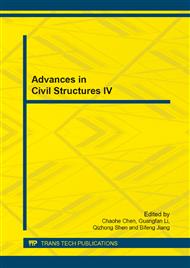[1]
Albert N. Noumowe, Rafat Siddique, G. Debicki. Noumowe (2007) Permeability of high-performance concrete subjected to elevated temperature (600℃ ) [J]. Construction and Building Materials, 2009, 23(5): 1855-1861.
DOI: 10.1016/j.conbuildmat.2008.09.023
Google Scholar
[2]
Cwirzen A, Penttala V, Vornanen C. Reactive Powder Based Concretes: Mechanical Properties, Durability and Hybrid use with OPC[J]. Cement and Concrete Research. 2008, 38(10): 1217-1226.
DOI: 10.1016/j.cemconres.2008.03.013
Google Scholar
[3]
Ju Yanzhong, Liu Hongxing, Wang Zhi. etc. The Design and Study of EHV Partially Prestressed Reactive Powder Concrete Pole[J]. Journal of Shenyang Institute of Engineering (Natural Science), 2009, 05(4):382-386 (in Chinese).
Google Scholar
[4]
Research on Design Theory and Mechanical Properties about RPC Slab Track of High Speed Railway[M]. Beijing Jiaotong University, 2008. 12 (in Chinese).
Google Scholar
[5]
ABAQUS Inc. ABAQUS 6. 12 Theory Manual. H.K. S,(2011).
Google Scholar
[6]
Zhou Xiaojun. The Comparison of Smeared Crack Model and Concrete Damaged Plasticity Model in ABAQUS[J]. Fujian Architecture and Construction, 2010, 143(5): 49-55 (in Chinese).
Google Scholar
[7]
Wang Yuzhuo, Fu Chuanguo. ABAQUS Application in Structural Engineering and Detailed Examples[M]. China Architecture and Building Press, Beijing, 2010. 03 (in Chinese).
Google Scholar
[8]
Jiang Ying, Wang Jiyang, Lou Wenjuan. Nonlinear FEM Analysis on RC Structural Wall with Large Eccentric Openings[J]. Journal of Shenyang Jianzhu University (Natural Science), 2010, 26(6): 1066-1072 (in Chinese).
Google Scholar
[9]
Application of ABAQUS Secondary Development in Finite Element Analysis of Concrete-filled Steel Tubular Structures [J]. Journal of Building Structures, 2013, 34(08):353-358 (in Chinese).
Google Scholar
[10]
Dong Yuli, Fan Chengmou, Pan Jinglong. Studies on the Constitutive Model of SFRC[J]. Journal of Harbin Archit. And Civ. Eng. Inst, 1993, 26(2): 86-92 (in Chinese).
Google Scholar
[11]
Song Yupu, Zhao Guofan, Peng Fang, etc. Endochronic Damage Constitutive Model for Steel Fiber Reinforced Concrete[J]. Journal of Hydraulic Engineering, 1995, 26(6): 1-7 (in Chinese).
Google Scholar
[12]
Wang Chunlai, Xu Bigen, Li Shulin, etc. Study on a Constitutive Model of Damage of SFRC Under Uniaxial Compression[J]. Rock and Soil Mechanics, 2006, 27(1): 151-154 (in Chinese).
Google Scholar
[13]
Xue Yunliang, Li Shulin, Lin Feng, etc. Study of Damage Constitutive Model of SFRC Considering Effect of Damage Threshold[J]. Rock and Soil Mechanics, 2009, 30(7): 1987-1999 (in Chinese).
Google Scholar
[14]
Yan Guangjie. Study on the Constitutive Model and failure Criteria of 200Mpa Reactive Powder Concrete[D]. Beijing Jiaotong University, 2005. 04 (in Chinese).
Google Scholar


